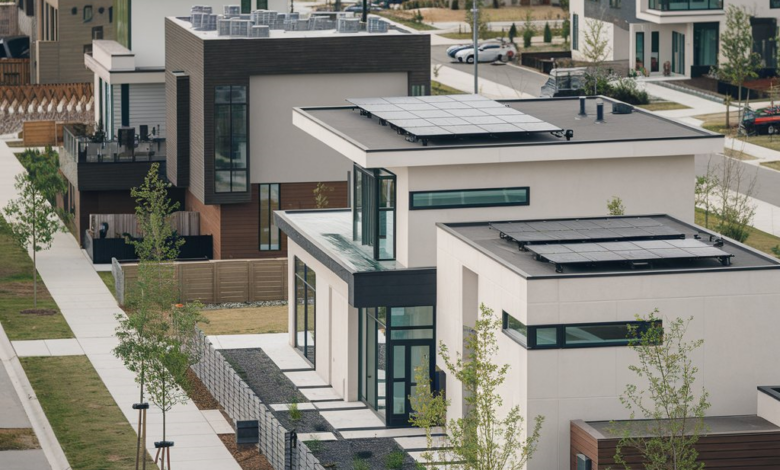The real estate market is constantly evolving, and as we enter 2024- 2025, it’s crucial for buyers, sellers, and investors to understand the trends shaping the industry. From shifting buyer preferences to rising interest rates, this year presents both challenges and opportunities.
This article explores key real estate market trends in 2024-2025, offering insights on housing inventory, pricing, mortgage rates, and more. Whether you’re a first-time homebuyer, an investor, or a seller, these trends will help you make informed decisions.

1. Higher Mortgage Rates Continue to Shape the Market
What to Expect with Mortgage Rates in 2024
Mortgage rates significantly impact housing affordability, and 2024 is expected to continue the trend of rising interest rates. After several years of historically low rates, the Federal Reserve’s efforts to curb inflation have resulted in steady increases. As of early 2024, mortgage rates are hovering between 6% and 7%, making it more expensive to borrow money for home purchases.

How This Affects Buyers
For homebuyers, higher rates mean that monthly mortgage payments will be larger, reducing the amount of home they can afford. This trend may slow down buyer demand, particularly among first-time buyers who are more sensitive to cost increases. However, if inflation stabilizes later in the year, there could be slight improvements in affordability.
What Sellers Should Know
Sellers may find fewer qualified buyers in 2024 compared to previous years. As rates rise, buyers may be priced out of certain markets, leading to longer listing times. To attract buyers, sellers may need to be more flexible with pricing or offer incentives like covering closing costs.
2. Home Prices Stabilize After Rapid Growth
A Cooling Housing Market
After years of rapid price growth, the housing market is expected to cool in 2024, with home prices stabilizing or even decreasing slightly in some regions. The combination of higher mortgage rates and slower demand has led to a more balanced market, giving buyers a better chance to negotiate.
According to industry experts, national home prices are forecast to increase modestly by 1-2% in 2024. However, in some overheated markets, prices may decline by 3-5%, offering relief to buyers who were previously priced out. This cooling is particularly noticeable in large metropolitan areas where prices surged during the pandemic.
Regional Variations
While national trends show stabilization, real estate remains a highly localized market. Cities in the South and Midwest may continue to see stronger price growth due to their affordability and population growth, while markets in the West Coast and Northeast could experience declines or stagnation.
What This Means for Investors
For real estate investors, the cooling market in 2024 could present buying opportunities, particularly in markets where prices decline. Investors with a long-term view may find it a good time to purchase rental properties or homes in areas poised for future growth.
3. Housing Inventory Remains Tight
Low Inventory Continues
One of the most significant factors affecting the real estate market in 2024 is the continued lack of housing inventory. Despite a cooling market, inventory levels remain well below pre-pandemic norms. This shortage is driven by several factors, including labor and material shortages in the construction industry, rising construction costs, and homeowners choosing to stay in their current homes due to higher interest rates on new mortgages.
Impact on Buyers
For buyers, especially those looking for entry-level homes, the tight inventory means competition remains high in many markets. While bidding wars may not be as fierce as in previous years, desirable homes are still selling quickly, and buyers need to be prepared to act fast.
New Construction Trends
Although new construction has ramped up in some areas, builders are focusing on higher-end homes due to profitability concerns. This leaves a gap in the market for affordable housing, which remains a challenge for first-time buyers and those looking for more modestly priced homes.
4. Suburban and Smaller City Markets Stay Strong
A Shift Away from Major Metros
One of the lasting effects of the pandemic has been the migration of homebuyers from large metropolitan areas to smaller cities and suburban markets. This trend is expected to continue in 2024, as remote and hybrid work models allow people to live farther from city centers.
Popular Markets for 2024
Cities in the Sunbelt region, including Texas, Florida, and Arizona, continue to attract buyers with their lower cost of living, favorable climate, and job growth. Mid-sized cities in the Midwest and Southeast are also seeing increased demand as they offer a more affordable alternative to the expensive coastal markets.
Opportunities for Buyers
For those looking to purchase a home in 2024, smaller cities and suburbs may provide more affordable options and lower competition. These areas are also attracting more development, which may lead to better infrastructure and amenities in the coming years.
5. The Rise of Sustainable and Green Homes
Growing Demand for Eco-Friendly Homes
Sustainability continues to be a significant trend in the real estate market. Homebuyers, particularly Millennials and Gen Z, are increasingly prioritizing energy-efficient and eco-friendly features when purchasing homes. This trend is expected to grow throughout 2024, with more buyers seeking homes equipped with solar panels, energy-efficient appliances, and sustainable building materials.
Government Incentives and Policies
Governments at both the state and federal levels are encouraging green home initiatives through tax credits and rebates for installing solar panels, energy-efficient windows, and smart thermostats. As energy costs rise, eco-friendly homes become more appealing for their long-term savings.
How This Affects Home Values
Homes with green features are not only more attractive to buyers but also tend to sell for higher prices and sell faster than homes without these features. As sustainability becomes a higher priority, more sellers may consider upgrading their homes to include eco-friendly features to stay competitive in the market.
6. Rental Market Continues to Expand
Increasing Demand for Rentals
The rental market is expected to remain strong in 2024, driven by the high cost of homeownership and rising interest rates. Many would-be homebuyers are opting to stay in the rental market longer due to affordability concerns. As a result, rental prices are forecast to rise by 3-5% nationally.
Rental Property Investment
Investors in the rental market will continue to benefit from this trend. With housing affordability becoming a barrier for many, the demand for rental properties—particularly single-family rentals—will remain robust. Investors looking for stable returns may find this a good opportunity to enter or expand in the rental market.
Rising Rent Control Discussions
As rental prices increase, discussions around rent control and tenant protection laws are gaining momentum in several cities. While this can impact profitability for landlords, it also emphasizes the need for affordable housing solutions.
Conclusion: Navigating the 2024-2025 Real Estate Market
The real estate market in 2024 presents a mixed bag of challenges and opportunities. For buyers, rising mortgage rates and low inventory may make finding the right home difficult, but stabilization in home prices and a shift toward smaller markets offer potential relief. Sellers will need to adjust their expectations as the market cools, but those with eco-friendly features may have an advantage. Investors, particularly in the rental market, can benefit from increasing demand for rental properties and opportunities in undervalued areas.
Whether you’re buying, selling, or investing, staying informed about these key trends will help you make strategic decisions in the year ahead.
For more information about Real Estate Market Trends in 2024-2025 you can search about these topics
2024 mortgage rate trends, real estate interest rates, home affordability 2024
housing price trends 2024, real estate market cooling, home price forecast 2024
housing inventory 2024, real estate supply shortage, new construction trends 2024
suburban housing trends 2024, real estate migration patterns, best cities for homebuyers 2024
sustainable real estate 2024, green home trends, energy-efficient homes
rental market trends 2024, real estate investment opportunities, rent price forecast
2024 real estate market trends, buying a home in 2024, housing market forecast

